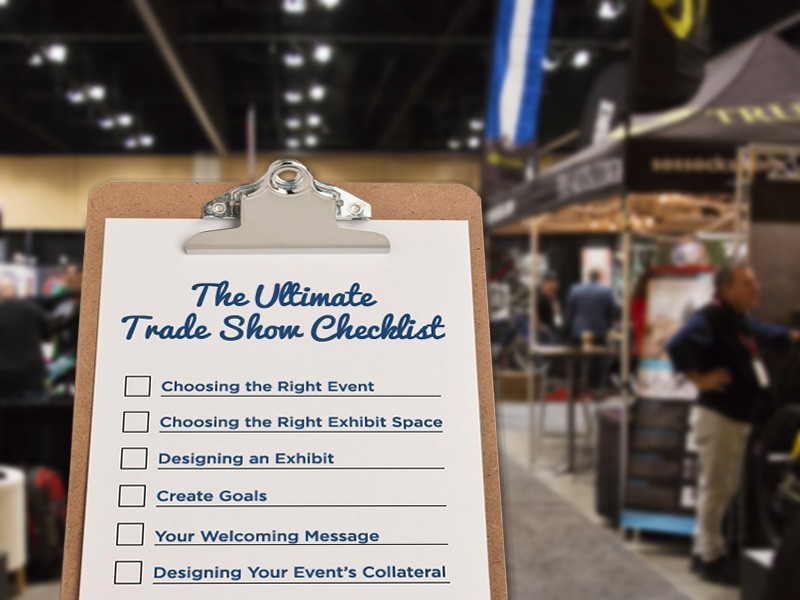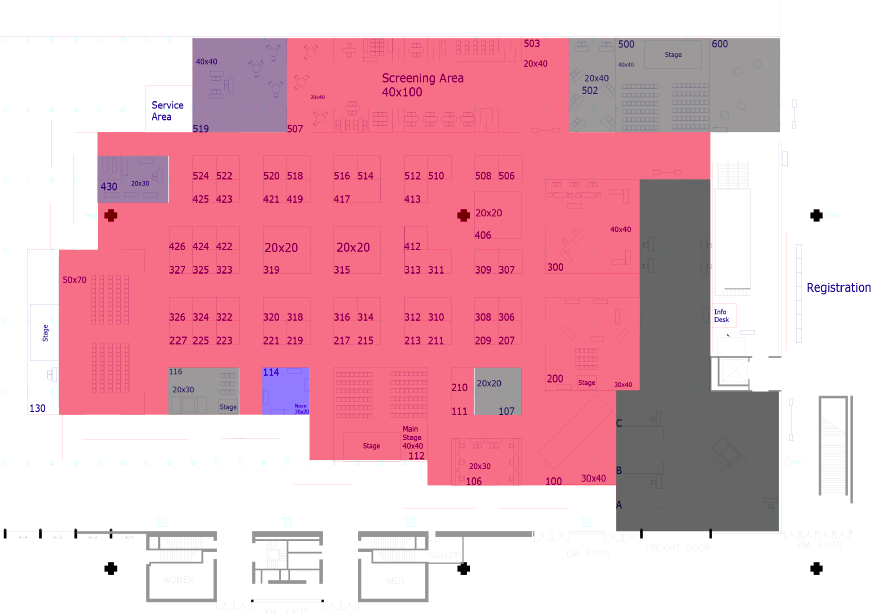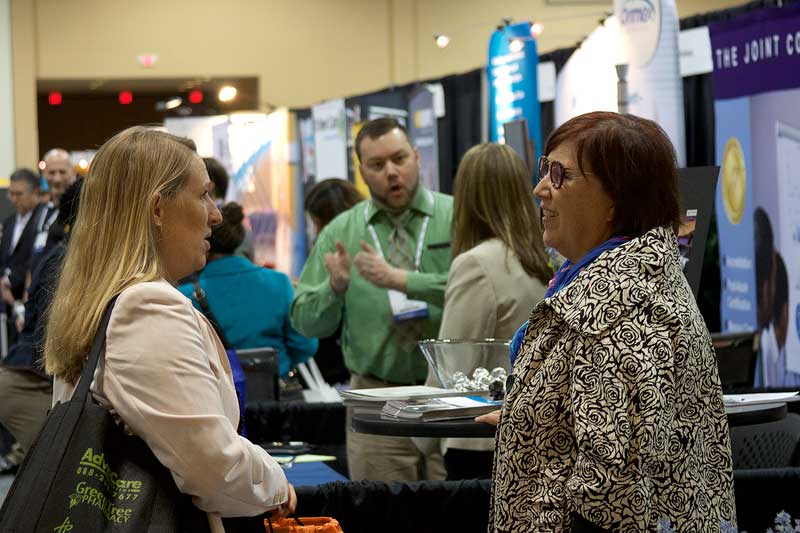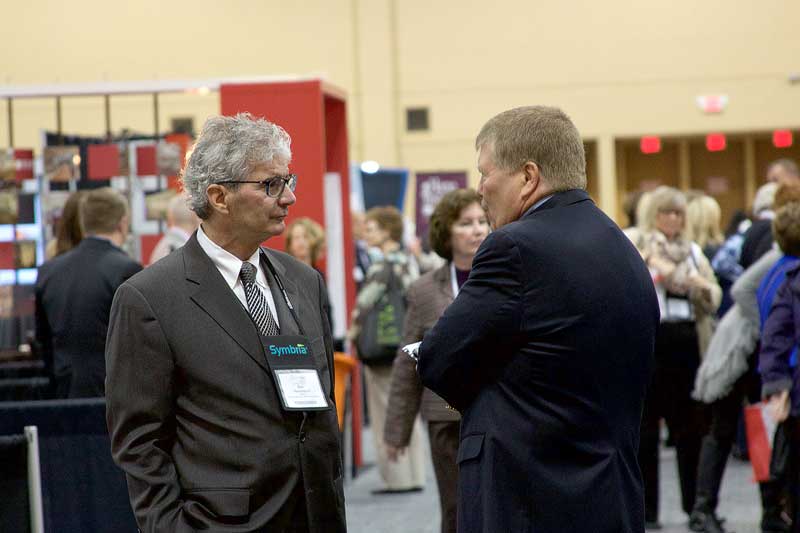
First time exhibiting at a trade show? Or maybe it’s just the first time you are managing a team, either way, we would like to help you! The beginning to any successful event starts with a plan. This guide will help you maximize all available opportunities pre, during, and post event.
| Pre-show
1. Choosing the Right Event

All of the steps outlined below don’t matter until you choose the right event. There are thousands of them out there and if proper research isn’t done before the event, you could be wasting your time and money.
2. Choosing The Right Exhibit Space

To ensure your team is in the right spot on the showroom floor, be sure to register immediately so you have a choice of space. The exhibiting space will go fast and keep in mind that certain shows use a point system for space selections, so get on it right away.
How to choose the right exhibit space:
-
Booth space near the front of the showroom is typically the best real estate but also has a higher price tag.
-
Many exhibitors like corner booths because of the flow of foot traffic.
-
Ask yourself: Do I want a corner space? An in-line booth? Or an island space?
-
Other important aspects to think about: How much space do I need? How can I maximize my booth space to contribute to my ROI?
3. Designing an Exhibit
You have a lot of options when planning the design of your booth. Depending on your budget and exhibiting space, make sure you decide on what best fits your event’s strategy. From custom designed booths and modulars to pop-up banners and portable displays; the options are limitless, you just have to figure out what best fits you.
4. Create Goals

Before heading to your event, you and your team must develop a list of goals to achieve on the showroom floor. Here’s a list of goal ideas that you and your team can develop to best fit your event strategy.
Goal Ideas:
-
Land five sales during the event
-
Generate 30 leads at the minimum
-
Find industry leaders and network
-
Get in-person market research on your product/services
5. Your Welcoming Message

Timing and messaging is everything so make sure you and your team have a game plan for capturing the attention of guests. Make your introductions short and to the point, you want to grab their attention immediately.
6. Designing Your Event’s Collateral
You will want to bring some type of event collateral with you such as promotional items for guests. Make sure the design for all collateral pieces are uniform and speak the same message; so that your guests have a clear understanding of your brand and what you do.
7. Promotional Items
Any type of giveaways or promotional items will help progress your messaging on the showroom floor. Think outside the box when purchasing these materials for your event, because the ones that have the most unique giveaways draw a lot of buzz to their booth. But don’t forget to check with show management on any rules regarding promotional items and giveaways.
8. Staffing Your Booth

When planning and staffing your booth, you must take in account a few aspects to ensure a successful event. Be sure to have at least two staffers in the booth at all times, so that opportunities aren’t missed. It’s also a good idea to have one to two more roaming around the space, to capture the attention of individuals walking near.
Reminder: Avoid standing behind the table in your booth space or near the back of the space. These barriers between you and your attendees will cause a decrease in social interactions. Also, instruct your staffer’s on appropriate body language and explain to them to avoid hawking.
9. Travel Arrangements
You don’t want to leave anyone behind due to travel times and traffic, so arrange transportation for your entire team to the airport and back. Also, book your flights, hotel rooms and rental cars soon after registering so that you aren’t surprised by unknown costs.
10. Pre-show Promotion
Building interest for the event beforehand is key to achieving your event goals. Pre-show promotion can include strategies such as direct mail, email marketing and social media. Don’t forget to pick up the phone too! You want to let your network know you will be in attendance and what they should expect at the event.
Tip: Try scheduling meetings with colleagues, prospects, leads and clients while at the event. You are there to progress your brand so make the most out of the opportunities, especially if the room is filled with a great deal of qualified individuals.
11. Booth Attire

You want to not only be comfortable, because you will be standing for a long duration, but your team also wants to be in attire that positively reflects your company. Discussing what is expected and what should be worn is a must in your pre-event conversations. First impressions are everything- make sure your team makes a positive one!
| During the event:
1. Engage with Attendees

Remember that as a staffer, you are representing the brand. How an attendee feels towards you will likely have an impact on how they feel towards your brand. Be sure to greet guests with a smile, a warm welcoming message and leave the sales pitch at home. Your success rate will increase if you are genuine and actually listen to the individual, rather than rehearsing your sales script, that you should have left at home!
2. Staffer’s Appearance
Like we said before, first impressions are everything! You want your staffers to have good body language, positive attitude and eagerness to communicate with attendees. Don’t allow staffers to sit down in the booth space, as this type of nonverbal communication will seem uninviting.
3. Avoid Barriers

Interacting with your attendees goes much further than just speaking with them. Be sure to get out from behind your booth and take a hands on approach. Not only will you seem more welcoming, but it’ll give you a chance to demonstrate your products and become one with your attendees. It can be as simple as getting out from behind your booth to give a handshake.
4. Onsite Demonstrations
A great draw to any booth space is a product demonstration. This gives you the ability to showcase your product to a regular audience of attendees. Here’s a way of also differentiating your product from your competitors. Make it a fun and memorable experience, because that’s how your guests are going to remember you.
5. Take notes

Due to the nature of a trade show or event, you are bound to meet dozens if not hundreds of people. To optimize your communication efforts and remember who’s who, take short but precise notes. The most efficient way to do this is taking notes on the individual’s business card you receive. Then, all their info and your notes are in one spot when you get back to your office.
6. Social Media
The conversation circling the event online is just as valuable as the conversations you’ve had onsite. Assign a staffer to manage your social media efforts during the event and have clear expectations of what should be published to your company’s accounts.
Social media during events is a great way to engage with an audience you might not have met yet and also shows you were apart of the conversation!
| Post-show:
1. Follow-up

It’s important to stay in contact with the individuals you meet on the showroom floor. By following up with prospects shortly after the event, your name and brand stay in the forefront. Don’t forget to add these contacts to your CRM and emailing list! If you did hire staffers, send them a hand written thank you note, that personal touch will go along way with them.
2. Reviewing Goals & Feedback

Additionally, you will want to measure the success of the show for your company. Be sure to review those goals set prior to the event and then carefully evaluate whether you met these goals. If your team achieved the goals set out before hand, be sure to capitalize on them. If you didn’t, review the unachieved goals as a team and make a plan on how to reach them at the next event.
Finally, be sure to ask for feedback from your colleagues and partners. Be specific by asking about your presence, your booth space and staffer’s appearance at the show. Also, ask for suggestions for improvement. By keeping notes on what worked and what didn’t, you have already begun planning for your next event.